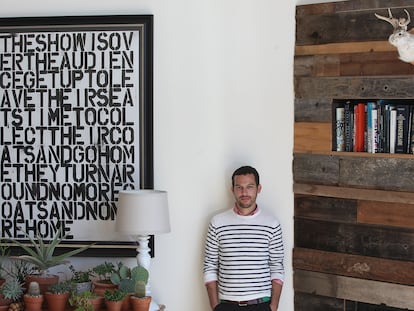Mariana Enríquez, writer: ‘A woman’s body has very particular fears’
The Argentine author returns to the disturbing world of ghosts and paranormal phenomena with a new collection of stories

The morning interview with Mariana Enríquez, 51, takes place just a few hours before the end of her eight-city book tour in Spain. In her new collection of stories — Un lugar soleado para gente sombría (or, A Sunny Place for Shady People) — she returns to the disturbing world of ghosts and paranormal phenomena. The Argentine author — best known for Things We Lost in the Fire (2016) and The Dangers of Smoking in Bed (2009) — manages to insert genius and humor into everyday reality.
Enríquez has legions of devotees. During her interview with EL PAÍS, she wears a t-shirt that a fan made for her, which bears an image of Orpheus. She speaks enthusiastically about the off-circuit Easter Week processions in Seville (those not recognized by the Catholic Church), which another of her readers took her to see. In the coming months, she has talks and meetings scheduled with readers in the United States, Puerto Rico, Lithuania, Ireland, Finland, France, Greece and Norway. She also plans to return to Madrid and Barcelona at the end of May.
Question. There are posters in the streets about your book tour. They seem to be advertising concerts rather than literary talks. Are you determined to prove that writers can be rock stars?
Answer. The publisher had this idea and I accepted. There’s a tradition of writers who made these tours: Oscar Wilde, García Lorca, Dickens... before this tour, I spent a whole year doing readings in theaters in Argentina. The show was called Don’t Bring Flowers and it was done with a cartoonist [who made the slides].
Q. Are you surprised by the fandom phenomenon that surrounds your literature?
A. I understand that more popular [or commercial] writing generates that. But in my case, it seems strange to me, because — beyond the horror books — I’ve written a biography on [the Argentine writer] Silvina Ocampo, an entire collection of journalistic work and about visits to cemeteries, strange things. But I don’t have any overbearing fans for now. It’s very exciting.

Q. In Mis muertos tristes (My Sad Dead) — the first story in your new book — the protagonist tells her ex-husband that “fascism generally starts with fear and turns into hatred.”
A. I wrote and published it in English a year-and-a-half ago, but the text dialogues with the present. This tendency towards the conspiratorial right began many years ago. There are ghosts that cannot be appeased.
Q. Do you believe in ghosts?
A. No, but only because I haven’t seen any. They must exist. Those in the story are of that social dissolution.
Q. Does literature allow us to understand the dynamics that push a person to their limits from a different perspective?
A. Each author is free to write about what they want, but this is a bit inevitable. Look at Hamnet (2020), a book about Shakespeare’s wife that ends up talking about the problems faced by some contemporary women.
Q. Is horror the best way to portray the present, or is it just your way?
A. It’s my way, but, as a popular genre, it has to talk about contemporary fears. Otherwise, it wouldn’t work.
Q. Is it premonitory?
A. Yes, because it’s digging into unconscious currents. Fear is an elusive sensation — when you touch upon it, you find something that ends up happening later.
Q. In the story Metamorfosis (Metamorphosis), you write about menopause. For women, is the body cause for fear?
A. A woman’s body has very particular fears. [Menopause] is a very long stage of life. What happens with aging, how your skin feels, what happens with sex, what happens with mood swings, what happens with hot flashes… there are many changes. Your body stops having the capacity to give birth: you’re carrying death. It announces the end to you in a much clearer way.
Q. Should this be spoken about more?
A. I think so, because we’re very focused on the period of motherhood and youth, but this only lasts until age 40. I also understand those who don’t want to talk about it, because it’s a moment that has something terrifying about it — an element of mourning — that’s difficult to face.
Q. After Javier Milei’s victory in the Argentine presidential elections — a politician who cloned his dog and uses a mystic to talk to his deceased mastiff — it appears that there’s actually some realism in your novel Our Share of the Night (2019).
A. You see? It’s the second time [in Argentina] that we have a spiritualist political leader. The first was José López Rega, who was known as Brother Daniel in his private circle. Juan Perón died and his minister was left governing with Isabel Perón [during her presidency in the 1970s]. That was my model of Argentine politics and folkloric esotericism. And, suddenly, it’s happening again. Clearly, there’s something in my work about capturing Argentine idiosyncrasies. But this [coincidence between reality and the novel] is very explicit: the dog, cloning, transferring a mind to another body. Of course, Milei is a phenomenon that was created during the pandemic, with social media.
Q. What do you feel is going on with social media?
A. It’s going through a difficult moment. To speak is always to expose yourself to misunderstandings, but on social media, it is to expose yourself to a [virtual] lynching. I feel some anxiety about it, but I eventually forget it and I start thinking about the new album that’s about to come out.
Q. Which album are you waiting for?
A. I’m really looking forward to three: the one by actor and musician Caleb Landry Jones, the one by Taylor Swift and the one by Nick Cave.
Q. Are you a Swifty?
A. Pretty much. She has lyrics that are better than stories. Her song Tolerate It (2020)... I hadn’t heard such incisiveness in years! Joni Mitchell had this ability too, but she’s a counterculture icon and Swift is in a stadium filled with 70,000 people singing a subtle heartbreak song. It’s elegant: she’s read F. Scott Fitzgerald and it shows.
Q. And what are your thoughts on Nick Cave’s work?
A. That’s religion. All of his esthetics, all of his search for transcendence. He hates being called “Gothic,” but that’s what he is, because he’s cathedral-like.
Translated by Avik Jain Chatlani.
Sign up for our weekly newsletter to get more English-language news coverage from EL PAÍS USA Edition
Tu suscripción se está usando en otro dispositivo
¿Quieres añadir otro usuario a tu suscripción?
Si continúas leyendo en este dispositivo, no se podrá leer en el otro.
FlechaTu suscripción se está usando en otro dispositivo y solo puedes acceder a EL PAÍS desde un dispositivo a la vez.
Si quieres compartir tu cuenta, cambia tu suscripción a la modalidad Premium, así podrás añadir otro usuario. Cada uno accederá con su propia cuenta de email, lo que os permitirá personalizar vuestra experiencia en EL PAÍS.
¿Tienes una suscripción de empresa? Accede aquí para contratar más cuentas.
En el caso de no saber quién está usando tu cuenta, te recomendamos cambiar tu contraseña aquí.
Si decides continuar compartiendo tu cuenta, este mensaje se mostrará en tu dispositivo y en el de la otra persona que está usando tu cuenta de forma indefinida, afectando a tu experiencia de lectura. Puedes consultar aquí los términos y condiciones de la suscripción digital.
More information
Archived In
Últimas noticias
Most viewed
- Sinaloa Cartel war is taking its toll on Los Chapitos
- Oona Chaplin: ‘I told James Cameron that I was living in a treehouse and starting a permaculture project with a friend’
- Reinhard Genzel, Nobel laureate in physics: ‘One-minute videos will never give you the truth’
- Why the price of coffee has skyrocketed: from Brazilian plantations to specialty coffee houses
- Silver prices are going crazy: This is what’s fueling the rally










































